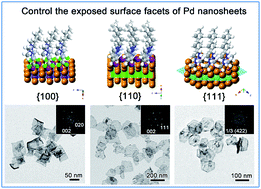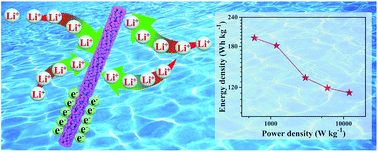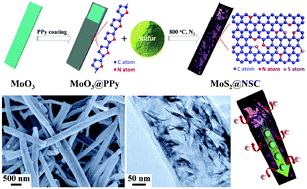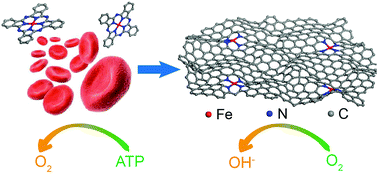
Shared posts
Ru Modulation Effects in the Synthesis of Unique Rod-like Ni@Ni2P–Ru Heterostructures and Their Remarkable Electrocatalytic Hydrogen Evolution Performance
Enhanced electrocatalytic performance for the hydrogen evolution reaction through surface enrichment of platinum nanoclusters alloying with ruthenium in situ embedded in carbon
DOI: 10.1039/C8EE00402A, Communication
PtRu alloy nanoparticles, surface-enriched with Pt nanoclusters and partially-embedded in carbon, act as the cost-effective and promising alternative to commercial Pt/C for electrocatalytic hydrogen evolution.
The content of this RSS Feed (c) The Royal Society of Chemistry
3D, Mutually Embedded MOF@Carbon Nanotube Hybrid Networks for High‐Performance Lithium‐Sulfur Batteries
Ultrathin palladium nanosheets with selectively controlled surface facets
DOI: 10.1039/C8SC00605A, Edge Article
 Open Access
Open Access   This article is licensed under a Creative Commons Attribution 3.0 Unported Licence.
  This article is licensed under a Creative Commons Attribution 3.0 Unported Licence.
Ultrathin two-dimensional palladium nanosheets with selectively exposed surface facets were controllably synthesized by designed functional surfactants.
The content of this RSS Feed (c) The Royal Society of Chemistry
Three-dimensional nitrogen-doped porous carbon anchored CeO2 quantum dots as an efficient catalyst for formaldehyde oxidation
DOI: 10.1039/C8TA00076J, Paper
A unique 3D structured composite composed of CeO2 quantum dots and CN is successfully constructed by a novel synthesis procedure to serve as an efficient HCHO oxidation catalyst.
The content of this RSS Feed (c) The Royal Society of Chemistry
Comprehensive Understanding of the Spatial Configurations of CeO2 in NiO for the Electrocatalytic Oxygen Evolution Reaction: Embedded or Surface-Loaded
Abstract
Introducing cerium (Ce) species into electrocatalysts has been recently developed as an effective approach to improve their oxygen evolution reaction (OER) performance. Importantly, the spatial distribution of Ce species in the hosts can determine the availability of Ce species either as additives or as co-catalysts, which would dictate their different contributions to the enhanced electrocatalytic performance. Herein, the comprehensive investigations on two different catalyst configurations, namely CeO2-embedded NiO (Ce-NiO-E) and CeO2-surface-loaded NiO (Ce-NiO-L), are performed to understand the effect of their specific spatial arrangements on OER characteristics. The Ce-NiO-E catalysts exhibit a smaller overpotential of 382 mV for 10 mA cm−2 and a lower Tafel slope of 118.7 mV dec−1, demonstrating the benefits of the embedded configuration for OER, as compared with those of Ce-NiO-L (426 mV and 131.6 mV dec−1) and pure NiO (467 mV and 140.7 mV dec−1), respectively. The improved OER property of Ce-NiO-E originates from embedding small-sized CeO2 clusters into the host for the larger specific surface area, richer surface defects, higher oxygen adsorption capacity, and better optimized electronic structures of the surface active sites, as compared with Ce-NiO-L. Above findings provide a valuable guideline for and insight in designing catalysts with different spatial configurations for enhanced catalytic properties.

Spatial distribution of CeO2 species as additives in the NiO host can dictate different contributions to the enhanced electrocatalytic oxygen evolution performance. The comparative study on two different catalyst configurations showed the benefits of embedding small-sized CeO2 clusters into NiO to modify the surface properties and structures and improve the activity as compared with CeO2 surface-loaded NiO.
Theoretical and Experimental Insight into the Effect of Nitrogen Doping on Hydrogen Evolution Activity of Ni3S2 in Alkaline Medium
Abstract
Nickel sulfide (Ni3S2) is a promising hydrogen evolution reaction (HER) catalyst by virtue of its metallic electrical conductivity and excellent stability in alkaline medium. However, the reported catalytic activities for Ni3S2 are still relatively low. Herein, an effective strategy to boost the H adsorption capability and HER performance of Ni3S2 through nitrogen (N) doping is demonstrated. N-doped Ni3S2 nanosheets achieve a fairly low overpotential of 155 mV at 10 mA cm−2 and an excellent exchange current density of 0.42 mA cm−2 in 1.0 m KOH electrolyte. The mass activity of 16.9 mA mg−1 and turnover frequency of 2.4 s−1 obtained at 155 mV are significantly higher than the values reported for other Ni3S2-based HER catalysts, and comparable to the performance of best HER catalysts in alkaline medium. These experimental data together with theoretical analysis suggest that the outstanding catalytic activity of N-doped Ni3S2 is due to the enriched active sites with favorable H adsorption free energy. The activity in the Ni3S2 is highly correlated with the coordination number of the surface S atoms and the charge depletion of neighbor Ni atoms. These new findings provide important guidance for future experimental design and synthesis of optimal HER catalysts.

Nitrogen-doped Ni3S2 nanosheets achieve excellent hydrogen evolution reaction (HER) performance in alkaline media. Both experimental and theoretical investigations suggest that the improved activity of nitrogen-doped Ni3S2 originates from enriched new active sites with favorable H adsorption. These new findings make inexpensive Ni3S2 more attractive and provide important guidance for future experimental design and synthesis of Ni3S2-based HER catalysts.
Heterogeneous phosphorus-doped WO3-x/nitrogen-doped carbon nanowires with high rate and long life for advanced lithium-ion capacitors
DOI: 10.1039/C8TA00639C, Paper
A high-performance lithium-ion capacitor anode comprising heterogeneous P-WO3-x/NC nanowires with high capacity, high rate and long cycle life is presented.
The content of this RSS Feed (c) The Royal Society of Chemistry
Light-weight 3D Co-N-doped hollow carbon spheres as efficient electrocatalysts for rechargeable zinc-air batteries
DOI: 10.1039/C8NR01140K, Paper
Facile synthesis of Co-N-doped hollow carbon spheres for rechargeable zinc-air batteries and the effect of their Co doping contents on ORR performance.
The content of this RSS Feed (c) The Royal Society of Chemistry
High-temperature solvent-free sulfidation of MoO3 confined in a polypyrrole shell: MoS2 nanosheets encapsulated in a nitrogen, sulfur dual-doped carbon nanoprism for efficient lithium storage
DOI: 10.1039/C8NR00068A, Paper
Yolk-shelled MoS2@NSC nanoprisms synthesized by high-temperature solvent-free sulfidation using MoO3@polypyrrole as the precursor manifest enhanced lithium storage properties.
The content of this RSS Feed (c) The Royal Society of Chemistry
Pd Metal Catalysts for Cross-Couplings and Related Reactions in the 21st Century: A Critical Review
Stable Metal–Organic Frameworks: Design, Synthesis, and Applications
Abstract
Metal–organic frameworks (MOFs) are an emerging class of porous materials with potential applications in gas storage, separations, catalysis, and chemical sensing. Despite numerous advantages, applications of many MOFs are ultimately limited by their stability under harsh conditions. Herein, the recent advances in the field of stable MOFs, covering the fundamental mechanisms of MOF stability, design, and synthesis of stable MOF architectures, and their latest applications are reviewed. First, key factors that affect MOF stability under certain chemical environments are introduced to guide the design of robust structures. This is followed by a short review of synthetic strategies of stable MOFs including modulated synthesis and postsynthetic modifications. Based on the fundamentals of MOF stability, stable MOFs are classified into two categories: high-valency metal–carboxylate frameworks and low-valency metal–azolate frameworks. Along this line, some representative stable MOFs are introduced, their structures are described, and their properties are briefly discussed. The expanded applications of stable MOFs in Lewis/Brønsted acid catalysis, redox catalysis, photocatalysis, electrocatalysis, gas storage, and sensing are highlighted. Overall, this review is expected to guide the design of stable MOFs by providing insights into existing structures, which could lead to the discovery and development of more advanced functional materials.

Stable metal–organic frameworks (MOFs) with high resistance to harsh chemical environments are reviewed with regard to recent progress in their research and development. Fundamental mechanisms of MOF stability, design and synthesis of stable MOF architectures, and their latest applications are summarized, providing a fundamental outline for the discovery of new stable MOFs.
Titanium Phosphonate Based Metal–Organic Frameworks with Hierarchical Porosity for Enhanced Photocatalytic Hydrogen Evolution
Abstract
Photocatalytic hydrogen production is crucial for solar-to-chemical conversion process, wherein high-efficiency photocatalysts lie in the heart of this area. A photocatalyst of hierarchically mesoporous titanium phosphonate based metal–organic frameworks, featuring well-structured spheres, a periodic mesostructure, and large secondary mesoporosity, are rationally designed with the complex of polyelectrolyte and cathodic surfactant serving as the template. The well-structured hierarchical porosity and homogeneously incorporated phosphonate groups can favor the mass transfer and strong optical absorption during the photocatalytic reactions. Correspondingly, the titanium phosphonates exhibit significantly improved photocatalytic hydrogen evolution rate along with impressive stability. This work can provide more insights into designing advanced photocatalysts for energy conversion and render a tunable platform in photoelectrochemistry.

A multi-structured photocatalyst: A metal–organic framework (MOF) nanostructure synthesized by a surfactant-directed strategy features a stable framework of titanium phosphates, a well-defined sphere, and hierarchical nanopores. These features ensure competitive photoactivity in evolving hydrogen under both visible light and full-spectrum simulator irradiation, along with high durability.
From biological enzyme to single atomic Fe-N-C electrocatalyst for efficient oxygen reduction
DOI: 10.1039/C7CC08149A, Communication
Inspired by metabolic processes in biological systems, animal blood as a biowaste rich in biological enzymes with molecular Fe-N centers was successfully explored to produce an efficient electrocatalyst with single atomic Fe-N-C active sites for oxygen reduction reaction.
The content of this RSS Feed (c) The Royal Society of Chemistry








